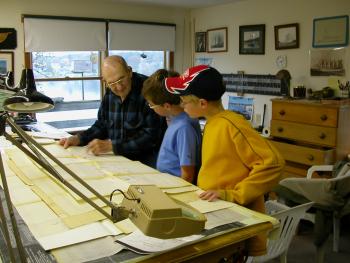Winfield Lash

Finding Friendship Oral History Project
The Finding Friendship Oral History Project is a joint effort of the Friendship Museum and the Friendship Village School, directed by Sally Merrick, museum volunteer, and Gaylea Hynd, teacher. In 2003-2004 sixth grade students conducted taped interviews of three generations of lobstermen and women, as well as others associated with the lobstering industry. Printed copies of the interviews and CDs of the printed transcripts are available at the Friendship Museum in Friendship, Maine.
Peggy Simmons
Winfield Lash, commonly known as Winnie Lash, was born on July 5, 1918, and spent the majority of his life in Friendship, Maine. He and his wife Barbara have been married for 63 years and have seven children, 17 grandchildren, and 13 great grandchildren. After working at the Camden Shipbuilding Company and Bath Ironworks, he worked at the W. S. Carter Boat Yard, which was owned by his uncle, Scott Carter. When his uncle died in 1946, he and Charles Sylvester bought the yard. Two years later, Sylvester sold his share to Winnie’s brother Douglas, and the yard became known as Lash Brothers. At one time or another, all of Winnie’s brothers worked there. The original boat shop burned down in 1987 and was replaced by a building on Route 97, where his son Wesley continues the Lash Brothers tradition. Now in his eighties, Winnie Lash bean working on boats at the Camden Shipbuilding Company, Bath Ironworks, and the W. S. Carter Boat Yard in Friendship. In 1946 he bought this yard with a partner from his uncle, and two years later he and his brother Douglas became the owners and changed the name to Lash Brothers. He is one of Friendship's most prominent boat builders and designers of sloops, fishing boats, lobster boats, and pleasure boats.
Scope and Content Note
Winfield discusses various aspects of his boat-building career. He began building boats around 1946, influenced by his family's involvement in the trade. When asked about the boat-building tradition in his family, Winnie suggested that it was a common tradition in the region. He shares that he was in charge of building approximately 100 boats, including fishing boats, draggers, pleasure boats, and lobster boats. He expresses his fondness for fishing boats, particularly draggers, but considered all boats equal in significance as long as they served their intended purpose. He mentions that the largest boat he built measured 71 feet, whereas the largest boat he designed reached 100 feet in length. Winfield was actively involved in designing most of the boats constructed at Lash Brothers. Lash Brothers primarily specialized in wooden boat construction, including sloops, fishing boats, lobster boats, and pleasure boats. When asked about the workforce in his shop, Winnie stated that the maximum number of employees reached thirteen. Building durations varied depending on the boat's size, ranging from three months for the shortest projects to a year and a half for the longest. While Winnie couldn't recall specific details about individual boats, he emphasized that he cherished the memories associated with the people he worked with. Despite the passage of time, many of the boats built by Winnie Lash and his team continue to be utilized by their owners. Accompanying the interview were photographs, including half-hulls of notable boats like the Five-masted Schooner B B Crowenshield, the 100' scallop dragger Jane and Ursula (the largest boat Winnie designed), and a 58-foot dragger designed and built by Winfield in 1988. Additionally, historical images showcased the site of Lash Brothers Boat Yard from 1926 to 1987, as well as a photograph featuring Winnie Lash and his brothers—Robert, Harold, Douglas, and Howard—with Philip and John not shown.
Please Note: The oral histories in this collection are protected by copyright and have been created for educational, research and personal use as described by the Fair Use Doctrine in the U.S. Copyright law. Please reach out Voices@noaa.gov to let us know how these interviews are being used in your research, project, exhibit, etc. The Voices staff can help provide other useful resources related to your inquiry.
The NOAA mission is to understand and predict changes in climate, weather, oceans, and coasts, to share that knowledge and information with others, and to conserve and manage coastal and marine ecosystems and resources. The Voices Oral History Archives offers public access to a wide range of accounts, including historical materials that are products of their particular times, and may contain offensive language or negative stereotypes.
Voices Oral History Archives does not verify the accuracy of materials submitted to us. The opinions expressed in the interviews are those of the interviewee only. The interviews here have been made available to the public only after the interviewer has confirmed that they have obtained consent.
